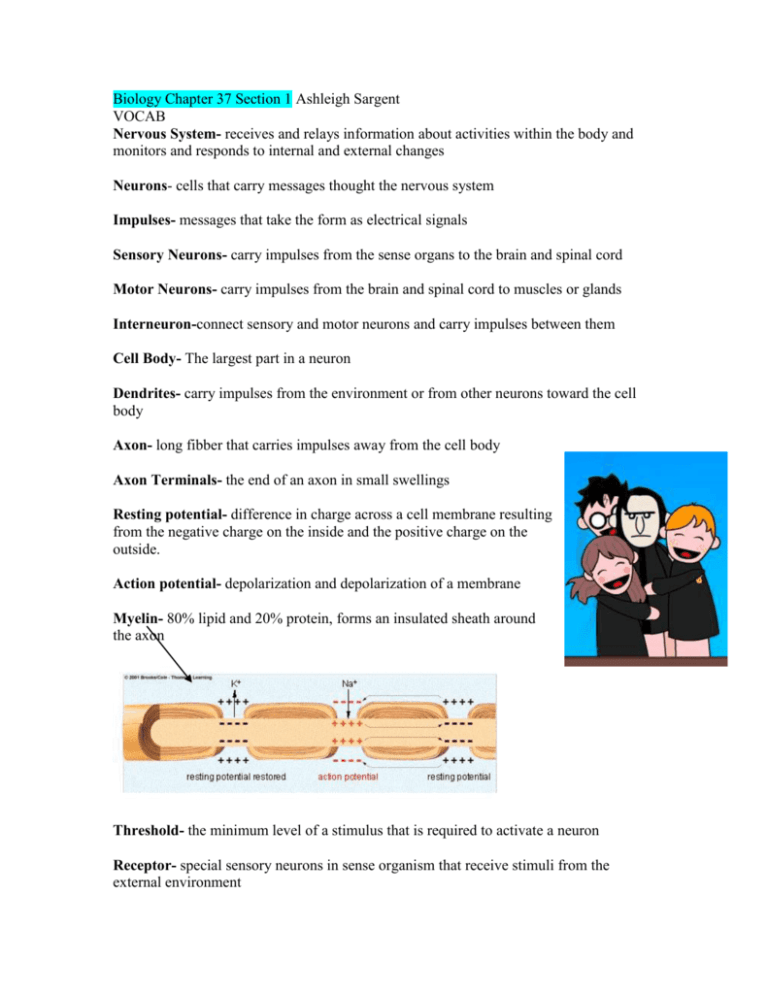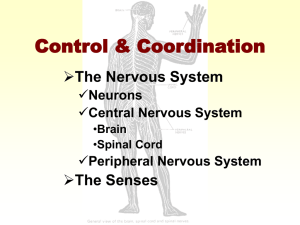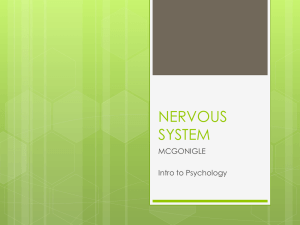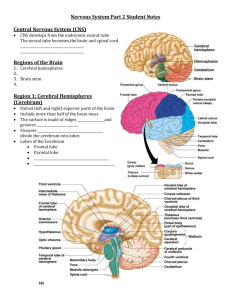Biology Chapter 37
advertisement

Biology Chapter 37 Section 1 Ashleigh Sargent VOCAB Nervous System- receives and relays information about activities within the body and monitors and responds to internal and external changes Neurons- cells that carry messages thought the nervous system Impulses- messages that take the form as electrical signals Sensory Neurons- carry impulses from the sense organs to the brain and spinal cord Motor Neurons- carry impulses from the brain and spinal cord to muscles or glands Interneuron-connect sensory and motor neurons and carry impulses between them Cell Body- The largest part in a neuron Dendrites- carry impulses from the environment or from other neurons toward the cell body Axon- long fibber that carries impulses away from the cell body Axon Terminals- the end of an axon in small swellings Resting potential- difference in charge across a cell membrane resulting from the negative charge on the inside and the positive charge on the outside. Action potential- depolarization and depolarization of a membrane Myelin- 80% lipid and 20% protein, forms an insulated sheath around the axon Threshold- the minimum level of a stimulus that is required to activate a neuron Receptor- special sensory neurons in sense organism that receive stimuli from the external environment Effectors- muscles or glands that bring about a coordinated response Synapses- points of contact at which impulses are passed from one cell to another Neurotransmitters- tiny vesicles filled with chemicals used by neurons to signal each other. The 5 sensory organs: Skin The vesicles holding the neurotransmitters fuse with the membrane and release the neurotransmitters, which are received by the special receptors. Eyes Ears Nose Tongue After the neurotransmitter detaches from the membrane of the cell, it is rapidly removed or destroyed Stimulus--Sensory Organs*---Brain and Spinal Cord (Processes info)—Motor neurons (In muscles and glands) Biology Chapter 37 Section 2 VOCAB Central Nervous System- serves as control center of the body consists of brain and spinal cord Peripheral Nervous System- consists of all the nerves and associated cells that are not part of the brain or spinal cord Nervous System Central (Brain and spinal cord) Peripheral Motor Somatic to skeletal muscles Sensory Autonomic to smooth muscle, cardiac muscle, glands Sympathetic Parasympathetic Biology Chapter 37 Section3 VOCAB Brain the main switching unit of the central nervous system; it is the places to which impulses flow from which impulses originate. Grey Matter- densely packed nerve cell bodies White matter- myelinated axons Spinal Cord- provides the link between the brain and the rest of the body Cerebrum- largest part of the human brain which is responsible for all the voluntary (purposeful) actions, intelligence, learning, and judgment. Separated into two hemispheres Cerebral Cortex- outer surface has grey matter, inner has white matter. Cerebral medulla- inner surface of the cerebral cortex made of white matter Cerebellum- 2nd largest matter of the brain, coordinates and balances the actions of the muscles. Brainstem- connects the brain to the spinal cord Medulla Oblongata- lowest part of the brainstem controls blood pressure, heart rate, swallowing, and coughing. Pons- link the cerebral cortex and the cerebellum Midbrain- smallest division of the brainstem that are involved in hearing and vision Thalamus- serves as switching station for sensory input and passes information to the proper region of the cerebrum. Hypothalamus- control center for hunger, thirst, fatigue, anger, and body temperature Reflexes- simplest response to a stimulus The blood vessels are in charge or providing the brain with oxygen and energy needed to adequately function. Functions of the Brain 1) Brain waves- Brain’s source of electrical activity - Brain waves vary during sleep and consciousness. 2) Sleep- state of unconsciousness in which a person can be awakened by a normal sensory stimulation - During deep sleep there is a decline in heart rate, blood pressure, respiratory rate, and use of energy. - REM (rapid eye movement) is when asleep and dreaming occurs. The brainstem helps to control consciousness. 3) Memory - Two different kinds of memory: Short termed (primary)- contains small amounts of information, such as name or telephone. Some evidence supports that it is stored as a pattern of the nerve impulses in the cerebral cortex. Most vanish within a few days. and Long-term memories may last forever, and some scientists think that long-term memories are stored in the structure of the brain as a whole. It is unsure as to where the memories are kept. THE SPINAL CORD - Acts as communications link between brain and the peripheral nervous system. - Regulates Reflexes - 31 pairs of spinal nerves originate in the spinal cord and branch out to both sides of the body. These carry messages to and from the spinal cord. - Contains two types of nerve tissue - The central is grey matter - The outer is white matter - Sensory neurons carry impulses from receptors to the spinal cord and motor neurons carry impulses from the spinal cord to the effectors. - Within the spinal cord, motor and sensory neurons are connected by interneurons. Biology Chapter 37 Section 4 VOCAB Sensory Division- part of the peripheral nervous system that transmits impulses from sense organs to the central nervous system Motor division- part of the peripheral nervous system that transmits impulses from the central nervous system to the muscles and glands (effectors) Reflex Arc- the quick response of the receptor, sensory neuron, motor neuron, and effecter Sympathetic Nervous System- opposite to Parasympathetic Nervous System Parasympathetic Nervous System- opposite to Sympathetic Nervous System- Part of Body Effect of the SNS Effect of the PNS Pupil Liver Urinary baldder muscle dilated glucose is released constrited none elaxed increased rate and force dilated contracted Muscle of the heart Bronchi slowed rate consticted - The motor division is split into the somatic nervous system and the autonomic nervous system. Somatic nervous system-Regulates activities that are under conscious control such as movement of skeletal muscles. Biology Chapter 37 Section 5 Sense Organ- five sense that have specialized cell that enable it to respond to particular stimuli VISION - Each eye has three layers: 1) Sclera and cornea 2) Choroid, ciliary body, iris 3) Retina The sclera helps maintain the eye shape attaches the muscles that move the eye. In the front of the eye, the sclera forms a transparent layer; the cornea. The cornea is the part which light enters. Inside the cornea, is a chamber filled with the liquid aqueous humor. At the back is the Choroid, which contains blood vessels. The pigment Choroid, then becomes the iris. In the middle of the iris is the pupil, where light enters the eye. Tiny muscles regulate the size of the pupil, in extreme light the pupil closes in dim light the pupil expands. Behind the iris is the lens which is made up of cells called crystalline which are almost transparent and allows light to come through. Small muscles allow the lens to bend slightly to focus on close or distant objects. Behind this is a large chamber filled with jelly like, transparent fluid called vitreous fluid. At the back of the eye is the retina which is made of special light sensitive receptor cells called photoreceptors. These convey light energy into impulses that are carried to the central nervous system. There are two types of photoreceptors: Rods sensitive to all colors of light, but not different colors Cones- less sensitive that rods, but respond differently to light or different colors; thus color vision HEARING AND BALANCE -External ear consists of the visible flesh part that helps collect sounds and funnel them into the auditory canal. The canal contains hair and wax producing glands to prevent foreign objects from entering the ear. The auditory canal extends into the bones of the head, but stops at the eardrum. The eardrum is the beginning of the middle ear. Sounds vibrations strike the ear and are then transmitted trough three tiny bones; the malleus, the incus, and the stapes. The stapes vibrates the oval window which transmits vibrations to the cochlea, which beings the inner ear. The cochlea is filled with liquid and the liquid vibrates and tiny hair cells lining the cochlea are pushed back and forth providing stimulation that sis turned into nerve impulses. These impulses are carried to the brain by acoustic nerve. Ears contain structures for detecting small stimuli that allow balance. Located with in the inner ear are two tiny sacs and semicircular canals that are filled with fluid and lined with hair cells (ciliated cell). The hair cells in the sac are imbedded in gelatinlike substances that contain tiny grains of calcium carbonate and protein called otoliths (hearing stones). Otolithes roll back and forth is response to gravity, acceleration, and deceleration. Together, the movement of fluid and the otholiths bend the hair on the hair cells. This sends impulses to the brain to determine body motion and position. SMELL - Smell is a chemical sense, and the chemoreceptors are responsible for smell. - These chemoreceptors are located in the upper part of the nose cavity. They contain cilia that extend into the air passageways of the nose and react to chemicals. - Chemicals that come in contact with the chemoreceptors stimulate them and cause impulses to be sent to the brain. TASTE - Sense of taste is a chemical sense. - The cells are also called chemoreceptors. - The taste buds detect taste and most are located on projections on the tongue. Taste buds are also found on roof of mouth, and on lips and throat. - Taste detects sour, bitter, sweet, and salty and each taste bud has a sensitivity to a particular sensations. TOUCH AND RELATED SENSES - The largest sense organ is skin. - There are several distinct types of sensory receptors. 2 react to heat and cold, 2 types other types respond to touch. 1 type responds pain Sensory receptors for heat and cold are scattered directly under the surface of the skin. Usually there are three to four warm receptors for every cold receptor. Sensory receptors for touch are much more concentrated in some ares, there are more on lips, toes, and fingers. Pain receptors are located throughout the skin. Ballad of Bilbo Baggins, gotta love the insanity!









